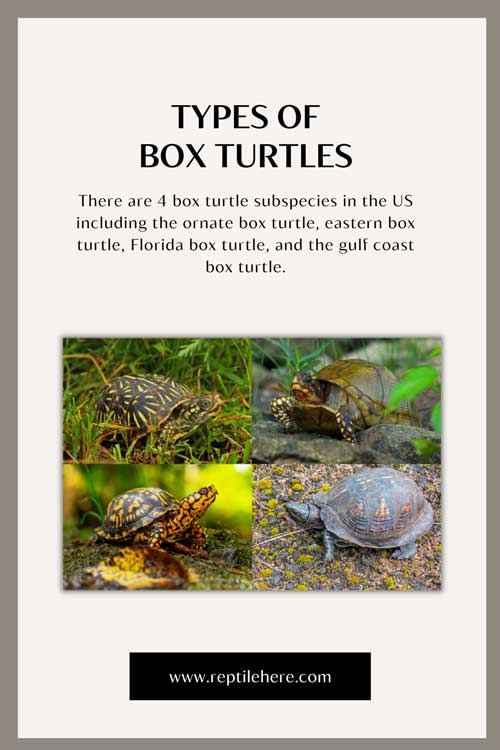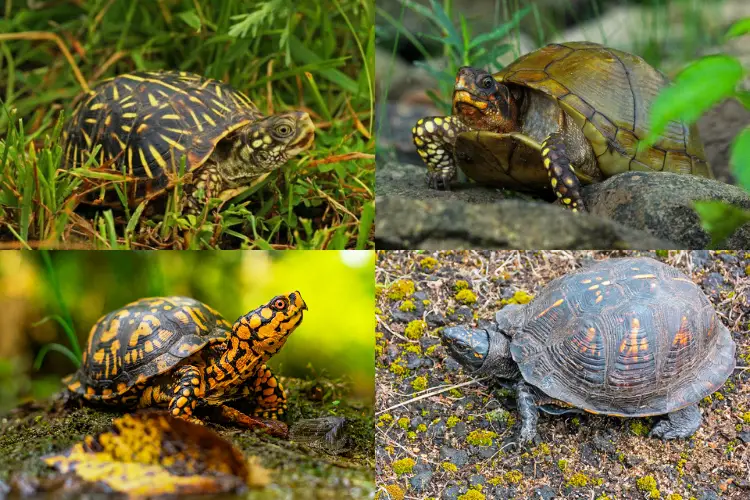Types of Box Turtles
If you’re wondering what types of box turtles are found in the United States, this guide is for you. There are 4 box turtle subspecies in the US including the ornate box turtle, eastern box turtle, Florida box turtle, and the gulf coast box turtle.
Box turtles are native to North America. They’re also known as box tortoises because they’re superficially similar to tortoises in their physical appearance and their terrestrial habits.
But unlike tortoises, they don’t get too large; the average adult size for a box turtle is around 5-7 inches. This size makes them ideal for keeping as pet turtles and can live for a long time if cared for properly.
Here’s the full list of box turtles in the United States. For each box turtle, we have discussed the physical appearance, habitat, diet, IUCN conservation status, and other helpful info you need to know.
1. Ornate Box Turtle
Contents
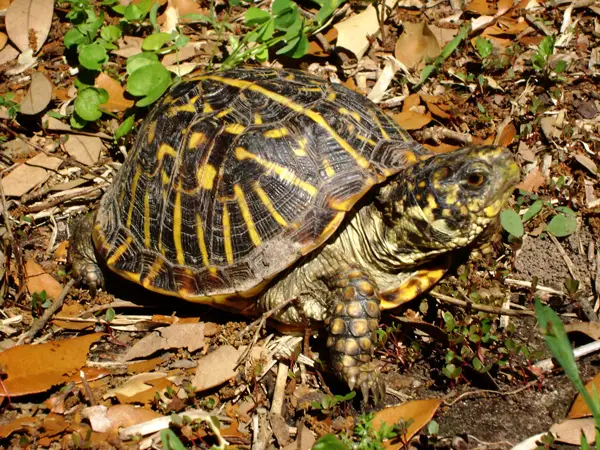
- Scientific name: Terrapene ornata
- Common name: Ornate Box Turtle, Western Box Turtle
- Family: Emydidae
- Size: 5 to 7 inches
- Lifespan: 40 to 60 years
- Conservation status: Near Threatened
Ornate box turtles are recognized by the beautiful pattern on their carapace. This eye-pleasing pattern is sometimes referred to as a starburst pattern.
Their skin is grey and may feature yellow or white spots. Male heads occasionally feature green color.
Though there exists a little distinction between the males and females of these box turtles, males are generally smaller than females.
During hot weather, this turtle requires water to help regulate its body temperature.
The species of turtle are known to hibernate in burrows during cold weather. They’re also capable of surviving in frozen soils for several days.
Being omnivorous in nature and opportunistic feeders, these turtles will gladly feed anything available to them in their habitat or what’s abundant in a given season.
They have been observed eating various insects, such as grasshoppers, and also fruits and vegetables.
2. Eastern Box Turtle
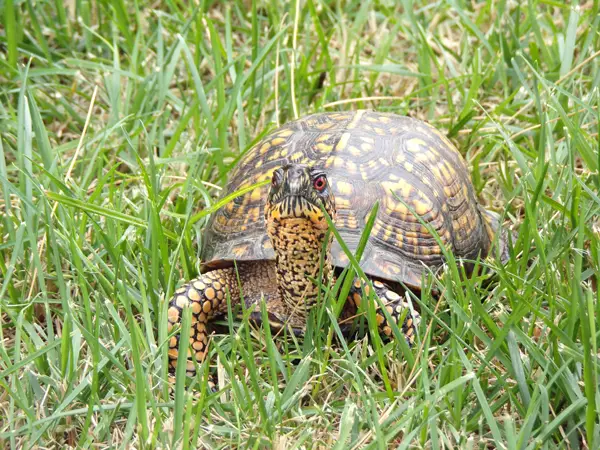
- Scientific name: Terrapene carolina
- Common name: Eastern Box Turtle, Land turtle, Box Turtle
- Family: Emydidae
- Size: 4.5 and 7 inches
- Lifespan: 50 to 100 years
- Conservation status: Vulnerable
The eastern box turtles usually inhabit dense thickets and woodland areas. They prefer these areas due to abundant access to sunlight and food sources nearby.
An adult turtle of this species is about 4.5 to 7 inches and weighs just 2lbs. It has a high, domed shell shape with a ridge running from head to toe. The shell of this turtle has varying colors of olive, brown, and tan.
The variation in markings on the shells of these turtles is so variable that you can’t easily recognize one by looking at the shell alone.
These eastern box turtles are omnivorous and feed on a variety of foods including insects, meat, fruits, vegetables, and various types of vegetation.
Note that eastern box turtles are taken from the wild for pet trade, leading to a decline in their population. For this reason, many states have illegalized capturing and selling of this species.
And those in captivity end up dying due to poor conditions or being abandoned or released back into the wild because they’re too demanding to maintain.
3. Florida Box Turtle
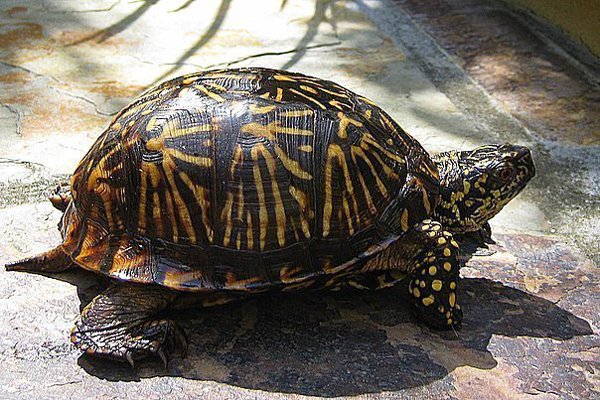
- Scientific name: Terrapene bauri
- Common name: N/A
- Family: Emydidae
- Size: 4.5 to 6.5 inches
- Lifespan: 25 to 30 years
- Conservation status: Vulnerable
The Florida box turtle is native to the state of Florida and the extreme southeastern part of Georgia.
Its distribution is widespread throughout Florida’s mainland, though it has also been observed in the Florida Keys region.
As one of the 4 common box turtle subspecies, this box turtle’s natural habitat involves swamps, marshes, and forests. The turtle likes lying in water but it doesn’t swim as often.
This box turtle has a dark (almost black shell) with impressive orange markings along with yellow stripes on its head.
Being omnivorous in nature, this turtle will eat strawberries, snails, insects, earthworms, slugs, mushrooms, and green-leafed vegetation. They have also been spotted eating quail eggs.
Florida box turtle is fairly small and tolerant to handling, making them a good pet choice. However, the law forbids owning more than two of these turtle species without a permit.
4. Three-Toed Box Turtle
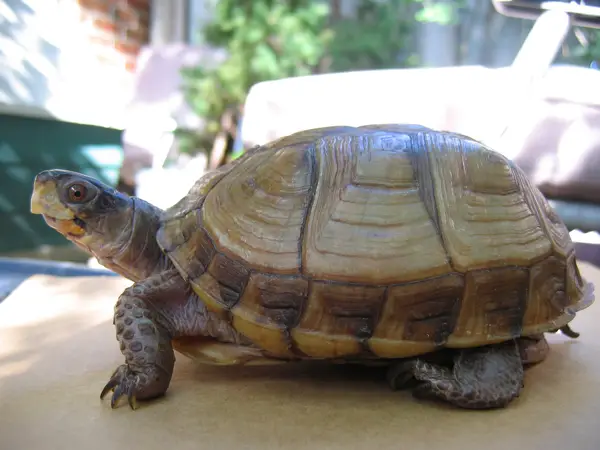
- Scientific name: Terrapene triunguis
- Common name: N/A
- Family: Emydidae
- Size: 4.5 to 5 inches
- Lifespan: 50 and 100 years
- Conservation status: Vulnerable
The three-toed box turtles inhabit the thickets, prairies, and woodlands of Alabama, Georgia, Louisiana, Florida, Missouri, Mississippi, Tennessee, Oklahoma, and Texas.
They’re easily identifiable by the 3 toes on their hind limbs, unlike the usual 4 toes on other box turtle species.
They have a uniform olive to brown shell color, sometimes with light spots or streaks. Bright yellow or orange spots are also occasionally spotted on the turtle species’ head and leg.
A mature three-toed box turtle has an average size of 4.5 to 5 inches.
They are unlike other box turtles in that they’re the only species that will remain healthy if you have them in indoor enclosures.
Being omnivorous in nature, these turtles are known to eat snails, insects, earthworms, slugs, mushrooms, strawberries, and green-leafed vegetation. They have also been spotted eating quail eggs.
5. Gulf Coast Box Turtle
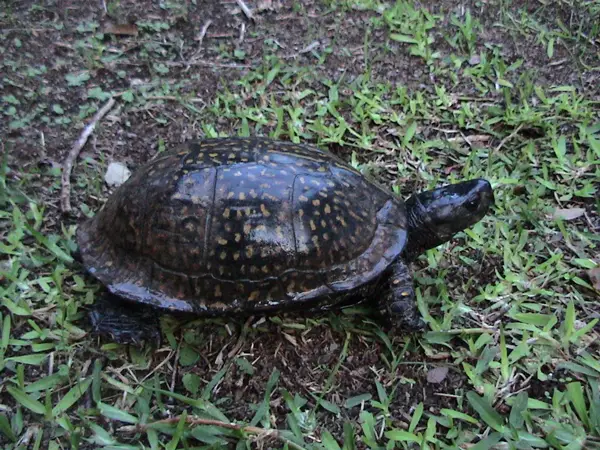
- Scientific name: Terrapene carolina major
- Common name: Gulf Coast box turtle
- Family: Emydidae
- Size: 6 to 8.5 inches
- Lifespan: 30 to 40 years
- Conservation status: Not extinct
The gulf coast box turtle is the largest of all the common box turtle subspecies. The turtle prefers living near Mississippi brackish waters, swamps, and estuaries.
It likes residing in warm and humid conditions.
The gulf coast box turtle has a dark brown or black shell with a fluted edge and yellow stripes or dots.
As for the skin, it is much darker than other box turtle species and ranges from black to dark brown.
This gulf coast box turtle is omnivorous. And its diet is mainly made up of insects, amphibians, and mollusks. It also occasionally feeds on plant matter.
Similar to the eastern box turtle above, this turtle also makes a good choice for a pet turtle.
Conclusion
The box turtles of the US include the ornate box turtle, eastern box turtle, Florida box turtle, and the gulf coast box turtle, and are mainly found in North America.
Note that these turtles are similar to tortoises in their physical appearance and their preferred terrestrial habits. However, they’re much smaller than tortoises, and the average adult size is around 5-7 inches.
If you want, you can keep a box turtle as a pet. With proper diet and good care, they’ll make great pets that can last from 30 to 100 years! (for the eastern box turtle)
